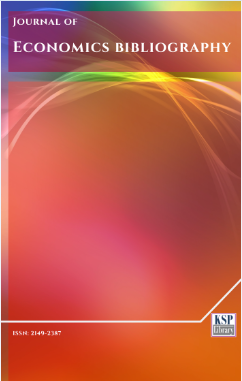“External Debt, Domestic Investment and Economic Growth in Cameroon” A system Estimation Approach
Abstract
References
Abid, H. et al. (2008). External debt and it impact on economic growth in Pakistan. International Research Journal of finance and economics, ISSW1450-2887, Euro Journal publishing Inc.
African Development Indicators (ADI)(1996). Privatization, Structural Adjustment and Economic Growth in indebted countries.
African Development Bank (2007). Selected statistics for Developing Nations
Agenor, Pierre and Peter Montiel (1996) Development Macroeconomics, Princeton, New Jersey: Princeton University Press.
Andrea, F. (2005). The debt-growth Nexus: A dynamic panel data estimation, Quaderno di Ricerca, n.23
Andrea, F. (2007). The debt-growth Nexus: A reassessment. Discussion paper No 2007-17, the open access, open assessment E-Journal
Athanasios, V. (2007). External debt and economic reform: Does a pain reliever delay the Necessary treatment? IMF working paper series No.WP|07|50 of the European Department.
Augustin, K. (1996). The impact of external debt on economic growth in Sub Saharan African countries, journal of economic development, vol. 21, No. 1 of June, 1996
Claessens (1990) “The Debt Laffer Curve: Some estimates,” World Development, Vol. 18
(December), pp. 1671-77.
Eduardo, L. (2007). Public investment in infrastructure in Latin America:Is debt the culprit? Inter-American Development bank, working paper series; 595, ideas for development in the Americas
Folorunso, S. & Felix, O. (2008). The impact of external debt on economic growth: A comparative study of South Africa and Nigeria, Journal of sustainable development in Africa, vol. 10, No. 3, 2008
Forgha, N. G. (2010). Foreign debt, economic growth and poverty reduction in developing countries: the Cameroonian experience. African journal of social sciences, vol. 1 No. 1, March, 2010
Forgha, N. G. (2008). Financing development from external sources: the African experience. Journal of applied social sciences, vol. 7, No. 2, 2008
Geske, D. & Niels, H. (2001). The uncertainty of debt service payments and economic growth of highly indebted poor countries: is there a case for debt relief? , Faculty of Public Policy, Erasmus University Rotterdam and Faculty of Management and Organization, University of Groningen (Unpublished)
Henrik (2006). Foreign direct investment and economic growth: A time series approach. The Berkeley Electronic press
IMF, (2006). Structural adjustment and poverty reduction in low income countries.
Karagόl, E. (2006). A critical review of external debt and economic growth relationship: a lesson for indebted countries (unpublished)
Karagόl, E. (2008). External debt and economic growth relationship using simultaneous equation, Atlantic journal of economics, Vol. 2, No. 2, may, 2009. University of Balikesir
Kutsoyiannis, A. (1977). Theory of econometrics, 2nd ed., Macmillan education Ltd.
Malese, D. (2005). External debt and economic growth in Ethiopia, African Institute of Economic Development and Planning, Senegal.
Maureen, W. (2001). The impact of external debt on economic growth and private investment in Kenya: An Empirical Assessment. Kenya institute for policy research and Analysis, Nairobi, Kenya, P.O box 56445.
Mbanga, G. N. & Sikod, F. (2008). Public debt and public investment in Cameroon.
Mbanga, G. N. & Sikod, F. (2006). Macroeconomic effect of debt-service reduction in Cameroon, faculty of economics and management, University of Yaoundé II, A Research proposal submitted to the AERC, Nairobi Kenya.
Mbanga, G.N. (2009). The structural adjustment programs, debt burden and poverty in Cameroon. Cameroon, a country at crisis crossroads: An anthology in the social Sciences, NAB ventures, Bamenda
Ministry of economic affairs and planning, Cameroon (1988). The fifth five year economic, social and cultural development plan 1981-1986, United Republic of Cameroon.
Molem, C.S., Molua, E.L., Ntangsi M.M., & Lambi, C.M. (2009). The gateway to Cameroons economic miracle.
Ntangsi, M. M. (2009). Constraints to sustainable growth in Cameroon. Cameroon, a country at crisis crossroads: An anthology in the social sciences, NAB ventures, Bamenda.
Ramesh, D. et al. (2008). The impact of external debt on economic growth, Journal of international finance & amp; economics.
Rena, E. & Abid, R. (2009). Crowding out effect of public borrowing: A case of Pakistan, a paper presented at the 8th national research conference on management and computer science in Islamabad.
Serven (1997) Uncertainty, “Instability and Irreversible Investment: Theory, Evidence and Lesson from Africa,” World Bank Policy Research Working Paper No. 1722 (Washington: World Bank).
World Bank (2004). Sub-Sahara Africa- From Crisis to Sustainable Growth: A long term perspective study. 1818H street, N.W., Washington, D>C> 20433, U.S.A
World Bank (2007). Strategies for sustainable growth and development in poor and developing countries of the world: is the path followed by the developed nations consistent?
World Bank (2012). The level of indebtedness and the performance of sub-Saharan African states: a dynamic study.
DOI: http://dx.doi.org/10.1453/jeb.v1i1.161
Refbacks
- There are currently no refbacks.
.......................................................................................................................................................................................................................................................................................................................................
Journal of Economics Bibliography - J. Econ. Bib. - JEB - www.kspjournals.org
ISSN: 2149-2387.
Editor: [email protected] Secretarial: [email protected] Istanbul - Turkey.
Copyright © KSP Library

